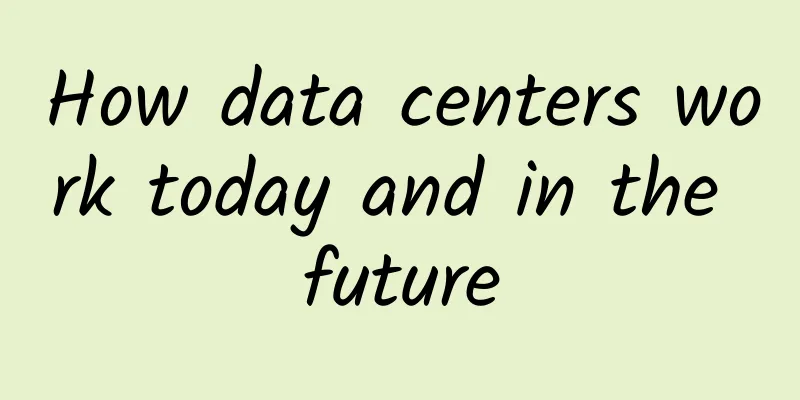How data centers work today and in the future

|
The data center of the future will rely on cloud computing, hyper-converged infrastructure, and more powerful components. A data center is a physical device that houses various business-critical applications and data information of an enterprise organization. Therefore, in the long run, as technology continues to develop, how to maintain the reliability and security of the data center is undoubtedly crucial for enterprise organizations. Components of a data center The data center is often viewed as a single thing, but in reality, it is a combination of many technical elements, including routers, switches, security devices, storage systems, servers, application delivery controllers, etc. These are the components of the most critical systems that IT needs to store and manage, which are essential to the continued operation of the enterprise. Therefore, the reliability, efficiency, security, and continuous evolution of the data center of an enterprise organization are usually the top priorities of the enterprise IT department. Data center infrastructure In addition to technical equipment, a data center also requires a lot of facilities infrastructure to keep its hardware and software running properly. This includes power subsystems, uninterruptible power supplies (UPS), ventilation and cooling systems, backup generators, and cabling to connect to the enterprise's external network operators. Data Center Architecture Any organization of any size is likely to have multiple data centers in multiple regions. This gives these organizations greater flexibility in backing up their information and also helps them to more effectively protect against natural and man-made disasters such as floods, storms and terrorist threats. Choosing the right data center architecture can be a difficult decision because there are almost unlimited options in this regard. Therefore, some key factors that organizations must consider when choosing a data center architecture include:
The analysis of the answers to these questions can more effectively help enterprise organizations determine how many data centers they need to build and where to invest. For example, a financial services company located in Manhattan, New York, may need to ensure long-term continuous normal operations, because any failure interruption may cause losses of up to millions of dollars. The company is likely to decide to build two data centers in places close to Manhattan, such as New Jersey and Connecticut, which are mirror sites of each other. The entire data center can be shut down at any time without any operational loss, because the entire company can fully rely on any one of the data centers to ensure normal operations. However, a small professional services company may not need instant access to information and can have a primary data center in its offices and back up information to alternate sites across the country every night. In the event of an outage, it will begin a recovery process, but with a different urgency than an enterprise that relies on real-time data for a competitive advantage. While data centers are often associated with enterprises and web-scale cloud service providers, in reality, any enterprise organization can have a data center. For some small and medium-sized enterprises, their data center may often be a server room located in their office space. Data Center Standards In order to help IT leaders in enterprise organizations better understand what kind of infrastructure should be deployed in data centers, as early as 2005, the American National Standards Institute (ANSI) and the Telecommunications Industry Association (TIA) released a data center standard that defines four different levels of design and implementation guidelines. A Tier 1 data center is basically a modified server room, while a Tier 4 data center has the highest system reliability and security. For a complete description of the data center standard, please visit TIA942.org (http://www.tia-942.org/content/162/289/About_Data_Centers). Future Data Center Technologies As with all technological developments, the current data center industry is undergoing a major technological transformation, and the data centers of the future will likely be very different from the enterprise data centers that most of us are familiar with today. As enterprise businesses become more dynamic and decentralized, data center technologies need to be more agile and scalable. With the further popularization of server virtualization technology, traffic across data centers (east-west) has greatly reduced traditional client-server traffic (north-south). This is a big disruption given that data center managers are actively trying to meet the needs of enterprise organizations in the IT age. Below, we will introduce some of the key technologies that have driven the evolution of data centers from static and rigid environments to enable enterprise organizations to have a fluid, agile infrastructure that can meet the needs of digital business. Public Cloud Services Historically, organizations have had the option of using a hosting provider or managed services partner to build their own data centers. This shifts ownership of the data center away from the enterprise, as well as the economic overhead of running the data center on its own, but the hassles of deploying and managing technology over a long period of time remain. The rise of Infrastructure as a Service (IaaS) from cloud service providers such as Amazon Web Services and Microsoft Azure has given enterprise customers an option to configure a virtual data center in the cloud with just a few clicks of the mouse. According to research data from market research firm ZK Research, more than 80% of organizations are planning hybrid environments, meaning that the vast majority of organizations are using a mix of private data centers and public cloud services. Software Defined Networking (SDN) A digital business can only be as agile as its latest agile components. This often involves the network. SDN can bring a level of dynamism that enterprise organizations have never experienced before. Hyperconverged Infrastructure (HCI) One of the operational challenges of a data center is having to mix the right mix of servers, storage, and networking equipment to support the demanding needs of applications. Then, once the infrastructure is deployed, IT operations need to figure out how to scale quickly without disrupting the application. Hyperconverged infrastructure simplifies scaling by providing an easy-to-deploy appliance based on commodity hardware by adding more nodes to the deployment. Early use cases for hyperconverged infrastructure revolved around desktop virtualization, but more recently it has expanded to other business application areas such as unified communications and databases. Container The application development process is often slowed down by the time required to configure the infrastructure. This can significantly hinder an organization's ability to move to a DevOps model. Container technology is a way to virtualize the entire operating environment, allowing developers to run applications and their dependencies in isolated systems. Containers are very lightweight and can be created and destroyed quickly, so they are ideal for testing how applications run under certain conditions. Differentiated network segment Traditional data centers have all security technologies at their core, as traffic is transmitted north-south, passing through security tools and protecting the business. The rise of east-west traffic means that current data center network traffic will bypass firewalls, intrusion prevention systems and other security systems and allow malware to spread very quickly. Micro-segmentation is a method of creating secure zones in a data center where resources can be isolated from each other, thus helping to minimize damage if a security breach occurs. Micro-segmentation is often done in software, making it very flexible. Non-Volatile Memory Express (NVMe) In today's increasingly digital world, everything is changing faster, which means data needs to be transferred faster. Traditional storage protocols such as Small Computer System Interface (SCSI) and Advanced Technology Attachment (ATA) have been around for decades and have reached their limits. NVMe is a storage protocol designed to accelerate the transfer of data information between the system and solid-state drives, greatly improving data transfer rates. GPU (Graphics Processing Unit) Computing Central processing units (CPUs) have powered data center infrastructure for decades, and Moore's Law has reached its physical limits. In addition, new workloads such as analytics, machine learning, and IoT are driving the need for a new computing model that goes beyond what CPUs can do. GPUs, once used only in the gaming industry, are fundamentally different because they are able to process multiple threads in parallel, making them ideal for data centers in the not-too-distant future. Data centers have always been critical to the success of organizations of almost all sizes, and that won’t change. However, the way data centers are deployed and the number of emerging technologies they are adopting are fundamentally shifting. To help build and plan a roadmap for the data center of the future, we need to be mindful of the fact that the world is becoming increasingly dynamic and distributed. Technologies that help accelerate the transformation of the data center are undoubtedly the ones that will be needed in the future. Technologies that fail to effectively drive data center transformation may continue to be adopted for a while, but will certainly become less and less important. |
<<: The impact of blockchain on data centers and cloud computing
>>: 8 trends in infrastructure development in 2018
Recommend
Prediction: Global enterprise-level WLAN equipment spending will reach $40 billion in the next five years
Market research firm Dell'Oro Group has just ...
Borei Data joins hands with Volcano Engine to build a new cloud and a new future
Recently, Volcano Engine officially released a fu...
Which of the three major operators has the first chance in 5G research and development? How will life be disrupted?
[[177286]] It is reported that my country will la...
Paving the way for innovative applications, all-optical networks are moving from enterprises to ordinary people's homes
[[386853]] From dial-up to ADSL, and then to fibe...
CommScope launches new access point portfolio to accelerate enterprise-class Wi-Fi 6 adoption
Shanghai, China, June 9, 2020 – CommScope recentl...
US operators confirm that only premium users can enjoy C-band 5G signals
According to foreign media reports, sources have ...
Failure to modernize data center infrastructure increases costs and risk of downtime
Today's data centers are more dynamic than ev...
China Unicom will gradually withdraw 2G network users and allow them to change their cards for free
2G will become history, users can change cards fo...
Google and Facebook to build new submarine cable connecting Japan and Southeast Asia in 2024
On August 16, Google and Facebook jointly announc...
50% off spinservers: San Jose data center starting at $19/month, dual core, 8G memory, 200G SSD, 10TB monthly traffic
In addition to dedicated servers, spinservers'...
My boss told me not to use strings to store IP addresses, no!
[[432371]] How to store IP address data in the da...
RepriseHosting: $27.97/month-L5640/16G memory/240G SSD/1Gbps bandwidth/Seattle data center
RepriseHosting is a foreign hosting company estab...
RAKsmart May Promotion: New Los Angeles servers starting at $30/month, VPS starting at $1.99/month, cluster servers/high bandwidth servers
RAKsmart launched a flash sale promotion for new ...
Why some cities are reluctant to adopt 5G
Most of the discussion about 5G has centered arou...
I have seven solutions for implementing real-time web messaging
I have a friend~ I have built a small website, an...









